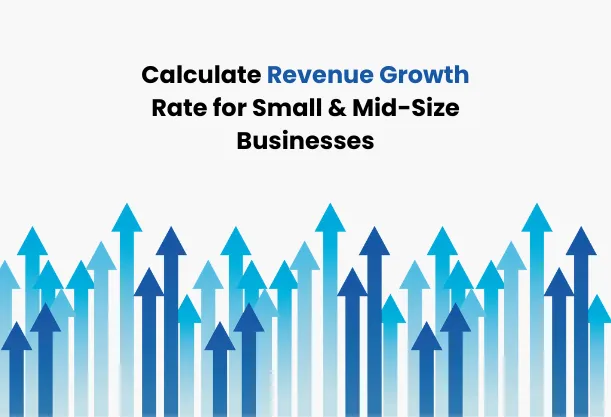
How to Calculate Revenue Growth Rate for Small & Mid-Size Businesses
Ever wondered how some companies seem to skyrocket in growth while others stagnate? The secret often lies in understanding and effectively managing their revenue growth rate.
Whether you're a business owner, investor, or entrepreneur, grasping this crucial metric can be the key to unlocking your company's potential and making informed decisions that drive success.
In this comprehensive guide, we'll dive deep into the world of revenue growth rates. You'll learn not only how to calculate this vital metric but also how to interpret and apply it to propel your business forward.
By the end of this article, you'll have the knowledge and tools to track, analyze, and leverage revenue growth rates like a pro.
Understanding Revenue Growth Rate
Before we delve into the nitty-gritty of calculations, let's break down what revenue growth rate really means and why it's so important.
At its core, revenue growth rate is a measure of how quickly a company's income is increasing (or decreasing) over time. It's expressed as a percentage and gives you a clear picture of your business's financial health and trajectory.
It's important to note that revenue growth rate is viewed differently depending on the stage and nature of the business:
- For startups, rapid revenue growth is often prioritized to demonstrate market traction and attract investors.
- Established businesses may focus on steady, sustainable growth that outpaces inflation and market averages.
- Investors use revenue growth rates to assess a company's potential for future returns and compare it to industry benchmarks.
To fully grasp revenue growth rate, you should be familiar with these related terms:
- Net Revenue: The total amount of income generated from sales after deducting returns, discounts, and allowances.
- Gross Revenue: The total amount of income generated from sales before any deductions.
- Year-over-Year (YoY) Growth: The percentage change in revenue compared to the same period in the previous year.
- Quarter-over-Quarter (QoQ) Growth: The percentage change in revenue compared to the previous quarter.
Why Calculating Revenue Growth Rate is Crucial for Business Success
Understanding and tracking your revenue growth rate isn't just a financial exercise—it's a powerful tool that can shape your business strategy and future.
Revenue growth rate plays a pivotal role in guiding critical business choices:
- Expansion: Strong growth may signal it's time to enter new markets or launch new products.
- Investment: Healthy growth can justify increased spending on marketing, R&D, or infrastructure.
- Resource Allocation: Growth patterns can help you decide where to focus your efforts and resources.
For businesses seeking funding, a robust revenue growth rate is often the golden ticket:
- It demonstrates business viability and market demand.
- It provides concrete evidence of your company's potential for return on investment.
- Consistent growth over time can help maintain investor confidence and support.
Your revenue growth rate is a key metric for competitive analysis:
- It allows you to gauge your performance against industry peers.
- It helps identify whether you're gaining or losing market share.
- It can reveal opportunities for improvement or areas where you're outperforming the competition.
Tracking revenue growth over time can uncover valuable insights:
- Seasonal patterns in your business cycle
- The impact of new product launches or marketing campaigns
- Early warning signs of potential challenges or opportunities
Types of Revenue Growth Rates
Not all revenue growth rates are created equal. Let's explore the three main types and when to use each one.
Year-over-Year (YoY) Growth Rate
YoY growth rate compares your revenue to the same period last year, expressed as a percentage.
Formula: YoY Growth Rate = (Current Year Revenue - Previous Year Revenue) / Previous Year Revenue x 100
When to Use
- For businesses with strong seasonal fluctuations
- To smooth out short-term volatility and focus on long-term trends
- When comparing performance across years
Example Calculation
Let's say your company's revenue was $1,000,000 in 2022 and $1,200,000 in 2023.
YoY Growth Rate = ($1,200,000 - $1,000,000) / $1,000,000 x 100 = 20%
Your YoY growth rate is 20%.
Quarter-over-Quarter (QoQ) Growth Rate
QoQ growth rate measures the change in revenue from one quarter to the next.
Formula: QoQ Growth Rate = (Current Quarter Revenue - Previous Quarter Revenue) / Previous Quarter Revenue x 100
When to Use
- For rapidly growing businesses or startups
- To identify short-term trends or the impact of specific initiatives
- When you need to make quick adjustments to your strategy
Example Calculation
If your Q1 revenue was $500,000 and Q2 revenue was $550,000:
QoQ Growth Rate = ($550,000 - $500,000) / $500,000 x 100 = 10%
Your QoQ growth rate is 10%.
Compound Annual Growth Rate (CAGR)
CAGR provides a smoothed growth rate over multiple years, assuming steady growth.
Formula: CAGR = (Ending Value / Beginning Value)^(1/n) - 1, where n is the number of years
When to Use
- For long-term performance analysis
- When comparing companies with different growth patterns
- To project future revenue based on historical performance
Example Calculation
If your revenue grew from $1,000,000 to $1,500,000 over three years:
CAGR = ($1,500,000 / $1,000,000)^(1/3) - 1 = 0.1447 or 14.47%
Your CAGR over the three-year period is 14.47%.
Step-by-Step Guide to Calculating Revenue Growth Rate
Now that we understand the different types of growth rates, let's walk through the process of calculating them.
Step 1: Gather Accurate Revenue Data
The old adage "garbage in, garbage out" applies here. Your calculations are only as good as the data you use, so ensure your revenue figures are accurate and consistent.
Where to Find Data
- Financial statements (income statements, annual reports)
- Accounting software (QuickBooks, Xero, etc.)
- Sales reports and CRM systems
Step 2: Determine the Type of Growth Rate to Calculate
Choose the appropriate metric based on your needs:
- YoY for annual comparisons and long-term trends
- QoQ for short-term analysis and rapid growth tracking
- CAGR for smoothed long-term growth rates
Step 3: Apply the Formula
- Identify the relevant time periods and corresponding revenue figures.
- Plug the numbers into the appropriate formula (YoY, QoQ, or CAGR).
- Perform the calculation, ensuring you're using the correct order of operations.
- Convert the result to a percentage by multiplying by 100.
Common mistakes to watch out for:
- Using gross instead of net revenue (or vice versa)
- Mixing up time periods
- Forgetting to convert the result to a percentage
Step 4: Analyze and Interpret the Results
A positive growth rate indicates your revenue is increasing, while a negative rate means it's declining. But the story doesn't end there:
- Compare your growth rate to your goals and industry benchmarks.
- Look for trends over multiple periods.
- Consider how your growth rate aligns with your overall business strategy.
Remember to consider external factors that might influence your growth rate:
- Economic conditions
- Market trends
- Competitive landscape
- Regulatory changes
Advanced Techniques for Revenue Growth Analysis
To gain deeper insights, consider these advanced approaches:
Accounting for Seasonality
If your business experiences seasonal fluctuations, try:
- Using a 12-month trailing revenue figure
- Comparing peak seasons year-over-year
- Calculating a seasonally adjusted growth rate
Segmented Analysis
Break down your growth rates by:
- Product lines or services
- Geographic regions
- Customer segments
This can help identify which areas of your business are driving growth or need attention.
Forecasting Future Revenue
Use historical growth rates to project future revenue:
- Calculate your average growth rate over several periods.
- Apply this rate to your current revenue to estimate future figures.
- Adjust for any known factors that might impact future growth.
Scenario Analysis
Assess how changes in revenue might impact your growth rate:
- Model best-case, worst-case, and most likely scenarios.
- Consider the impact of new product launches, market expansions, or economic shifts.
Factors Influencing Revenue Growth Rate
Understanding what drives your growth rate is crucial for maintaining and improving it.
Internal Factors
- Business Operations: Efficiency, productivity, and scalability
- Product Offerings: Innovation, quality, and market fit
- Pricing Strategies: Competitive positioning and value perception
- Marketing Effectiveness: Customer acquisition and brand awareness
External Factors
- Market Conditions: Industry growth, market saturation
- Economic Environment: GDP growth, inflation, interest rates
- Competitor Actions: New entrants, pricing changes, innovation
- Regulatory Changes: New laws or policies affecting your industry
Customer Behavior
- Customer Loyalty: Retention rates and repeat purchases
- Customer Acquisition: New customer growth and marketing efficiency
- Customer Lifetime Value: Long-term revenue potential per customer
Innovation and Technology
- Adoption of New Technologies: AI, automation, digital transformation
- R&D Investment: New product development and improvement
- Tech-Driven Efficiencies: Cost reduction and scalability improvements
Common Pitfalls to Avoid When Calculating Revenue Growth Rate
Be aware of these potential traps that can lead to misinterpretation or poor decision-making.
Misinterpreting Short-Term Fluctuations
Don't mistake temporary spikes or dips for long-term trends. Always look at growth rates over multiple periods to get a more accurate picture.
Ignoring External Influences
Remember that your growth rate doesn't exist in a vacuum. Always consider market conditions, economic factors, and competitive actions when interpreting your results.
Overemphasis on Growth
While growth is important, it shouldn't come at the expense of profitability or sustainability. Balance your focus on growth with other key financial metrics like profit margins and cash flow.
Practical Applications of Revenue Growth Rate in Business
Now that you understand how to calculate and interpret revenue growth rates, let's explore how to put this knowledge into action.
Incorporating Growth Rates into Revenue Projections
Use your historical growth rates as a starting point for forecasting future revenue. Adjust these projections based on your business plans, market conditions, and other relevant factors.
Guiding Business Strategy
Let your growth rate inform key strategic decisions:
- If growth is slowing, it might be time to explore new markets or product lines.
- If growth is accelerating, consider investing in infrastructure to support expansion.
- Use growth rates to set realistic goals for your team and track progress.
Regular Tracking and Analysis
Make revenue growth rate a key part of your regular financial reviews:
- Monitor growth rates monthly or quarterly to spot trends early.
- Use growth rate analysis to identify areas of your business that need attention or improvement.
- Celebrate wins when you hit or exceed your growth targets.
Communicating with Investors
Use revenue growth rates to tell your company's story to investors:
- Highlight consistent growth as a sign of business health and potential.
- Explain any fluctuations in growth and your plans to address challenges.
- Use growth rates to support your case for additional funding or investment.
Tools and Resources for Calculating and Analyzing Revenue Growth Rate
Leverage these tools to streamline your growth rate calculations and analysis.
Online Tools and Calculators
- Google Sheets: Free and easy to use for basic calculations
- Financial Calculators: Websites like Calculator.net offer specialized growth rate calculators
Financial Software
- QuickBooks: Offers built-in reporting features including revenue growth analysis
- Tableau: Powerful data visualization tool for more advanced analysis
- Power BI: Microsoft's business analytics tool for creating interactive dashboards
Templates and Spreadsheets
- Excel Templates: Many free templates are available online for tracking and calculating growth rates
- Custom Spreadsheets: Create your own tailored to your specific business needs
Case Studies: Real-World Examples of Revenue Growth Calculation
Let's look at how real businesses have used revenue growth rate analysis to drive success.
Startup Success Story: TechNova
TechNova, a SaaS startup, used its impressive 150% YoY revenue growth rate to secure $10 million in Series A funding. By demonstrating consistent growth over its first two years, TechNova convinced investors of its strong market fit and scaling potential.
Established Business Turnaround: RetailGiant
RetailGiant, a struggling brick-and-mortar chain, reversed its declining growth rate by analyzing segmented QoQ growth data. They identified that their e-commerce division was growing at 30% while physical stores were shrinking at 5%. This led to a strategic shift towards online sales, resulting in an overall growth rate turnaround from -2% to +15% within a year.
Industry Benchmarking: FintechFocus
FintechFocus, a medium-sized financial technology firm, used CAGR to benchmark its performance against industry peers. Their 25% CAGR over five years outpaced the industry average of 18%, helping them attract top talent and secure favorable terms with partners.
Conclusion
Mastering the art of calculating and interpreting revenue growth rates is a game-changer for any business. It provides invaluable insights into your company's performance, helps you make data-driven decisions, and communicates your success story to stakeholders and investors.
Remember, revenue growth rate is more than just a number—it's a powerful tool that can shape your business strategy and drive long-term success.
By regularly tracking and analyzing your growth rates, you'll be better equipped to navigate challenges, seize opportunities, and stay ahead of the competition.
Now that you have the knowledge and tools at your disposal, it's time to put them into action. Start by calculating your current revenue growth rate and use it as a baseline for setting future goals.
With consistent monitoring and strategic application of these insights, you'll be well on your way to sustainable, long-term growth.

 Rohit Kapoor
Rohit Kapoor

